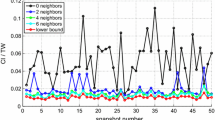Abstract
A packet radio network (for example, wireless LAN, mobile tactical network) consists of a number of nodes, each equipped with a transceiver, exchanging data packets via radio channels. In this paper we identify and discuss issues related to the process of forming a network in an automatic and distributed manner. During network initialisation and reconfiguration, the time to complete the network formation process is an important performance parameter. We define two measures which can be used for computing the network formation time. Also, we present a comparative evaluation of two channel-scanning schemes (synchronous and asynchronous) for multiple frequency operations using a broadcast access scheme based on CSMA. Our study of networks with different spatial distributions of nodes shows that the asynchronous scanning scheme performs better when the ratio of the number of 1-hop neighbours to the number of available channels is high. Its performance is somewhat worse than that of the synchronous scheme for sparse networks. It is also sensitive to changes in the channel dwell time of the receivers, compared with the synchronous case.
Similar content being viewed by others
References
R.T. Adair, An automatic link establishment standard for automated digital HF radio, in: IEEE MILCOM’ 89 Conference Record (1989).
D.J. Baker and A. Ephremides, The architectural organisation of a mobile radio network via a distributed algorithm, IEEE Transactions on Communications 29(11) (November 1981) 1694–1701.
D.J. Baker, J. Wieselthier and A. Ephremides, A distributed algorithm for scheduling the activation of links in a self-organising, mobile, radio network, in: Proceedings IEEE International Conference on Communications, ICC’ 82 (June 1982) pp. 2f6.1–2f6.5.
A. Ephremides and T.V. Truong, Scheduling broadcasts in multi-hop radio networks, IEEE Transactions on Communications 38(4) (April 1990) 456–460.
M. Gallagher, S.A.W. Bennett, M. Darnell and B. Honary, Advanced radio system architectures to integrate network and frequency management, in: Proceedings IEE Conference on HF Radio Systems and Techniques (July 1994) pp. 310–314.
R.J. Goodwin and A.P.C. Reed, Design consideration for an automated high frequency data network with adaptive channel selection, Technical Report, NTIS No. N89-18578/9/HDM (December 1988).
G.A. Halls, HIPERLAN: the high performance radio local area network standard, Electronics and Communication Engineering Journal 6(6) (December 1994) 289–296.
J.L. Hammond and J.D. Spragins, Rapidly re-configuring communication networks: Definition and major issues, in: Proceedings IEEE INFOCOM’ 87 (1987) pp. 202–206.
A. Hauptschein and M. Kajor, Recognition and self-organisation of nodes into DTDMA nets, IEEE Transactions on Aerospace and Electronic Systems 17(4) (July 1981) 531–542.
E.E. Johnson, Message throughput of automated HF data networks, Private Communication to S.C. Cook, ERL, DSTO (June 1992).
A.O. Mahajan, A.J. Dadej and K.V. Lever, A framework for performance evaluation of self-organising networks, in: Proceedings IEEE Singapore International Conference on Networks, SICON’ 93 (September 1993) pp. 839–844.
A.O. Mahajan, A.J. Dadej and K.V. Lever, Modelling and evaluating self-organising radio networks using OPNET, in: Proceedings TTCP STP-8 Workshop on Technology and Systems Issues involved in Establishing Robust Wireless Links for Supporting the ATM Protocol and Structure in a Military Field Operations Network, DSTO Salisbury (31 January–3 February 1995).
A.O. Mahajan, A.J. Dadej and K.V. Lever, Modelling and evaluating self-organising functions in radio networks, in: Proceedings IEEE Global Communications Conference, GLOBECOM’ 95, Singapore (1995) pp. 1507–1511.
A.O. Mahajan and K.V. Lever, A self-organisation functional plane for distributed mobile wireless networks, in: Bringing Telecommunications Services to the People – IS&N’ 95, Proceedings of 3rd International Conference on Intelligence in Broadband Services and Networks, Lecture Notes in Computer Science 998 (Springer, 1995) pp. 225–236.
OPNET Manuals, Release 2.4 (MIL3 Inc., Washington, DC, 1993).
I.E. Pountourakis and E.D. Sykas, Stability and throughput optimisation of multi-channel slotted non-persistent CSMA random choice protocol, Electronics Letters 30(17) (August 1994) 1387–1388.
M.B. Pursley and S.D. Sandberg, Delay and throughput for three transmission schemes in packet radio networks, IEEE Transactions on Communications 37(12) (December 1989) 1264–1274.
T.G. Robertazzi and P.E. Sarachik, Self-organising communication networks, IEEE Communication Magazine 24(1) (January 1986) 28– 33.
N. Shacham, Hierarchical routing in large, dynamic ground radio networks, in: Proceedings of the 18th Annual Hawaii International Conference on System Sciences (1985) pp. 292–301.
N. Shacham and P.J.B. King, Architectures and performance of multichannel multihop packet radio networks, IEEE Journal on Selected Areas in Communications 5(6) (July 1987) 1013–1025.
C. Warner, R. Merk, G.J. Brown and C.M. Keune, Hand-off assigned multiple access (HAMA): A new multiple access protocol for computer communications networks, in: Proceedings IEEE Military Communications Conference, MILCOM’ 83 (1983) pp. 183–189.
P. Wong and F. Halsall, Mobile computing in a LAN environment, in: IEEE International Conference on Communications, SUPERCOMM/ICC’ 94, New Orleans, USA (1994) pp. 1116–1120.
Z. Zhang and Y. Liu, Multichannel ALOHA data networks for Personal Communications Services (PCS), in: Proceedings IEEE Conference on Global Telecommunications, GLOBECOM’ 92 (1992) pp. 21–25.
Author information
Authors and Affiliations
Rights and permissions
About this article
Cite this article
Mahajan, A., Dadej, A. & Lever, K. A comparison of channel scanning schemes for distributed network formation and reconfiguration. Wireless Networks 4, 341–351 (1998). https://doi.org/10.1023/A:1019172827137
Issue Date:
DOI: https://doi.org/10.1023/A:1019172827137




